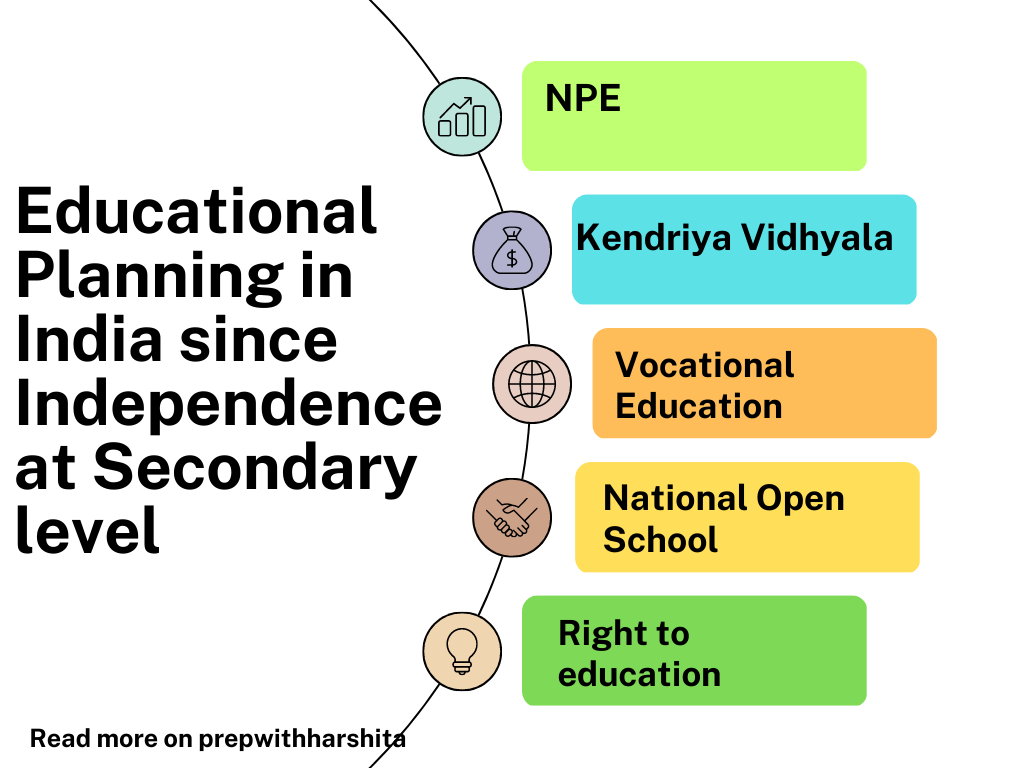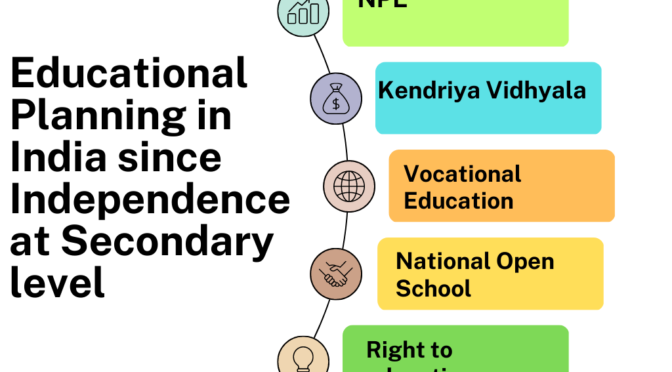Education planning in India since independence has undergone many changes and developments at the secondary level.
Educational Planning in India since Independence :
- National Policy on Education (1968): The National Policy on Education (NPE) was adopted in 1968, which emphasized the need for expanding secondary education and improving its quality. The policy recognized that secondary education was critical for the overall development of the country and the individual.
- Kendriya Vidyalayas (1963): The Kendriya Vidyalayas (KVs) were established in 1963 to provide quality education to the children of government employees who were frequently transferred. These schools follow a common curriculum and provide education up to the senior secondary level. KVs have expanded significantly over the years, and there are currently around 1,200 KVs in the country.
- Expansion of Navodaya Vidyalayas (1985): The Navodaya Vidyalayas (NVs) were established in 1985 to provide quality education to rural children. These schools provide free education and boarding facilities to talented children from economically weaker sections of society. The NVs have expanded over the years, and there are currently around 660 NVs in the country.
- Vocational Education: Vocational education was introduced in the secondary education system in the 1970s to provide students with the necessary skills for employment. This was expanded in the 1980s and 1990s with the introduction of vocational courses in areas such as agriculture, engineering, and health.
- National Open School (1989): The National Open School (NOS) was established in 1989 to provide education to those who have dropped out of the formal education system or who are unable to attend regular schools due to various reasons. The NOS offers courses at the secondary and senior secondary levels, and its curriculum is designed to cater to the needs of learners from diverse backgrounds.
- Sarva Shiksha Abhiyan (2001): The Sarva Shiksha Abhiyan (SSA) was launched in 2001 to provide free and compulsory education to all children between the ages of 6 and 14. The program aimed to improve access to education and reduce dropout rates. The SSA also focused on improving the quality of education through various measures such as teacher training, infrastructure development, and curriculum reform.
- Right to Education Act (2009): The Right to Education (RTE) Act was passed in 2009, which made education a fundamental right for all children between the ages of 6 and 14. The RTE Act aimed to provide free and compulsory education to all children in the country. The act also provided for the establishment of neighborhood schools and the appointment of trained teachers.
- Rashtriya Madhyamik Shiksha Abhiyan (RMSA) (2009): The (RMSA) was launched in 2009 to provide access to quality secondary education to all children in the age group of 14-18 years. The RMSA aims to improve the infrastructure of secondary schools, provide teacher training, and promote vocational education.
- National Skills Qualification Framework (NSQF) (2013): The National Skills Qualification Framework (NSQF) was introduced in 2013 to provide a common reference framework for all vocational qualifications in the country. The NSQF aims to align the vocational education system with the needs of the industry and promote employability.
- Samagra Shiksha Abhiyan (2018): The Samagra Shiksha Abhiyan was launched in 2018 by merging the Sarva Shiksha Abhiyan, RMSA, and the Teacher Education Program.
Also visit: Prep with Harshita



Keep on adding this type of informative content. Hope to read more from you. Thank you. Hope read more from you. Try India’s most trusted complete School Management Software along with Mobile Apps, specially designed for Indian schools. One solution for all your school’s needs.